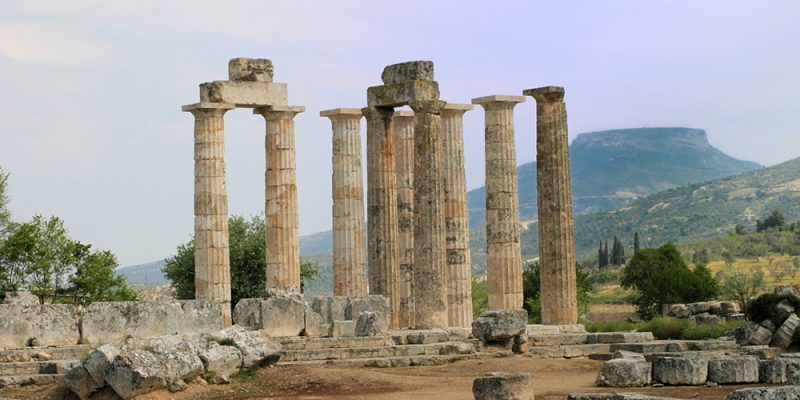ARCHAEOLOGICAL SITE AND MUSEUM OF ANCIENT CORINTH
If you want to visit the richest city in the ancient world, then Ancient Corinth is your destination. The archaeological site of Ancient Corinth is located at the northern foot of the hill of Acrocorinth, around the archaic Temple of Apollo. Extensive excavations have brought to light the city’s Roman Bazaar, temples, fountains, galleries, baths and a variety of other monuments. The excavations extended to the Acrocorinth fortress in the south of the organized archeological site, in prehistoric settlements in the Corinthian plain in the north such as the hill of the prehistoric settlement of Korakos, Agios Gerasimos, Gonia and Gyriza. To the south of the organized archaeological site came the Theatre, the Roman Conservatory, the sanctuary of Asclepius and Hygiene (Asclepieion), cemeteries, ceramic workshops (Kerameikos), walls, as well as a variety of other buildings such as the French Quarter and significant and Ottoman monuments.
Restricted in scope and results, research was carried out during the years 1892 and 1906 by A. Skias at the expense of the Archaeological Society. Systematic excavations in the area that continue to this day, began in 1896 by the American School of Classical Studies.


ACROCORINTH
Your tour of the Peloponnese should definitely include the castle of Acrocorinth. It is the largest castle in Moria, which has been used since ancient times as “the eye of the Peloponnese overseer”. The imposing rock saw in its history moments of heroism, strife and greatness. It was built on the mountain of the same name, at an altitude of 575 meters, and its walls today have a total perimeter of more than 3,000 meters enclosing an area of about 240,000 square meters. The castle includes a large uneven courtyard and is a typical example of fortress architecture.
Excavations began in 1961 by the American School of Archeology. It was established during the time of the mythical king of Corinth, Sisyphus, and its first fortification dates back to the end of the 7th-6th century BC, during the years of tyranny of the Hive. After a long history of “ownership” alternations by Romans, Franks, Venetians, Turks, in 1823 with the liberation of Corinth the castle was surrendered to the Greek troops. This is the reason why, in Acrocorinth, works of wall construction in various eras, Mycenaean, classical, Byzantine and medieval, ie Turkish and Venetian, are recognized.
The view from the Acrocorinth will take your breath away. In front of you stretches the whole Corinthian land, up to the borders of Argolida and opposite Central Greece. Above Geraneia and up to the borders of Achaia.
ST. PAUL’S STEP
The Rostra (Step) of the Roman Market
During his stay in Corinth, St Paul the Apostle was brought before the viceroy of France, commander of Corinth, on charges of preaching “illegal beliefs.” France, however, refused to prosecute him, claiming it was an internal matter of the city’s Jewish community.
According to the sacred tradition, the place where Paul was taken is the Step, the great platform located in the center of the Roman Agora of Ancient Corinth, from where the officials addressed the citizens.
Apparently, due to his connection with the Apostle, the Step was converted into a Christian church during the Byzantine period.
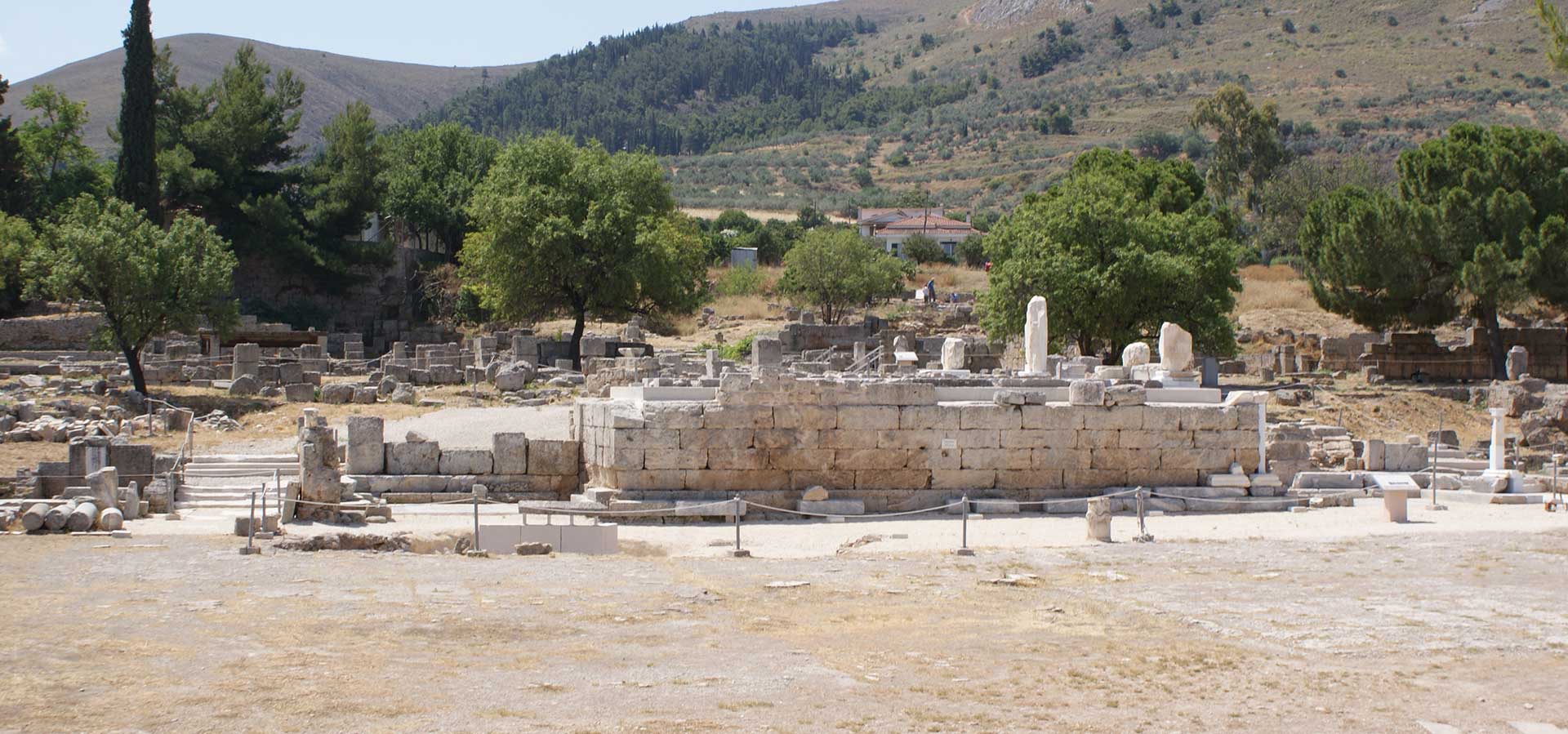
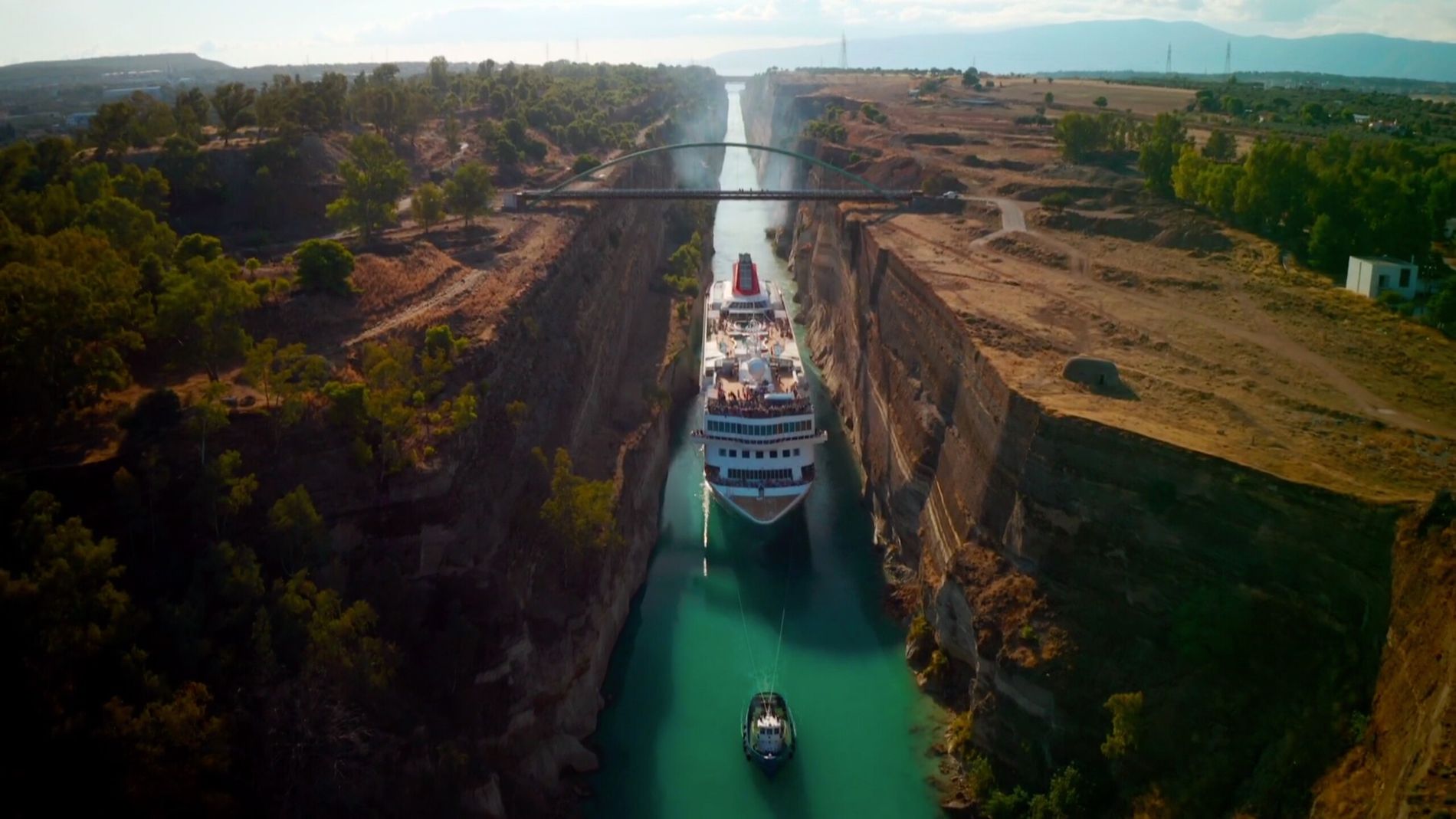
CORINTH CANAL (ISTHMUS)
The Corinth Canal (Greek: Διώρυγα της Κορίνθου, romanized: Dhioryga tis Korinthou) is a man made canal in Greece, that connects the Gulf of Corinth in the Ionian Sea with the Saronic Gulf in the Aegean Sea. It cuts through the narrow Isthmus of Corinth and separates the Peloponnese from the Greek mainland, arguably making the peninsula an island. The canal was dug through the Isthmus at sea level and has no locks. It is 6.4 kilometres (4 mi) in length and only 24.6 metres (80.7 feet) wide at sea level, making it impassable for many modern ships. It is currently of little economic importance becoming mainly a tourist attraction.
The canal was initially proposed in classical times and a failed effort was made to build it in the 1st century AD.[4] Construction recommenced in 1881 but was hampered by geological and financial problems that bankrupted the original builders. It was completed in 1893, but, due to the canal’s narrowness, navigational problems, and periodic closures to repair landslides from its steep walls, it failed to attract the level of traffic expected by its operators.
ISTHMUS DIOLKOS
The inventive Corinthians realized from a very early age – perhaps from the 9th century BC – that the importance of the Isthmus, beyond a defensive line, was very important for navigation and in particular that the small width of the Isthmus could allow ships to pass through. one sea to another (from the Corinthian Gulf to the Saronic Gulf and vice versa) and to facilitate East-West communication, eliminating the dangerous and extremely distant route of the Peloponnese and the Cape of Malea.
In this context, with the well-known ingenuity, diligence, intelligence and knowledge of engineering, they began to build a corridor across the Isthmus that started from the current area of Poseidonia and ended at Schiounountas (today’s Kalamaki), without following a straight path. to avoid large uphills and downhills that would strain the executors of the ship’s tow. This treadmill was named Diolkos and was the world’s first fixed-track vehicle.
As can be seen from the excavations carried out by the famous archaeologist Nikos Verdelis (which were essentially stopped), from 1956 to 1962, Diolkos took the form that exists to this day from Periandros, who built it with large, stone, stone slabs, which had two grooves in the middle, which were about 1.50 m apart. and aimed to make the “tugs” (of the vehicles where the ships were loaded) safer and faster.
Diolkos remained in operation for 1600 years and until 1154, according to a map by the Arab geographer Edresi.
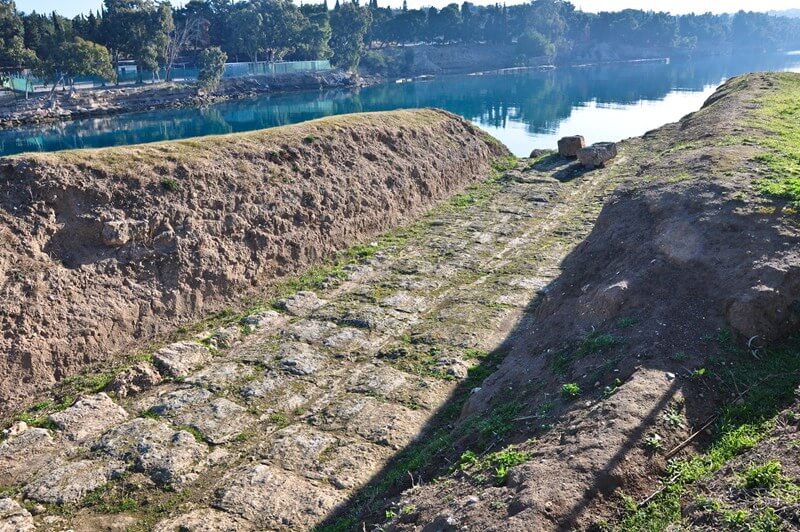
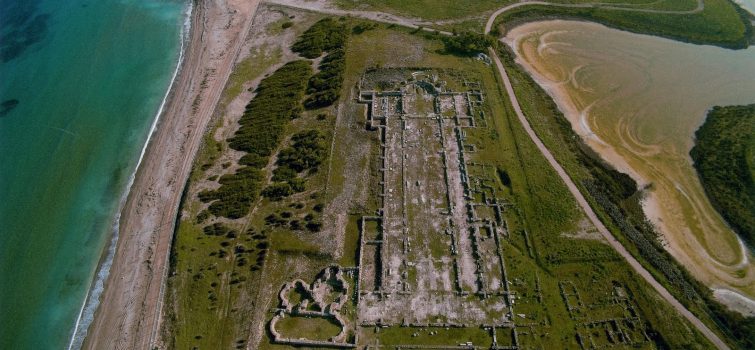
ANCIENT PORT OF LECHAIO
The port of Lechaeum was the main port – port of Ancient Corinth, a marvel of know-how and technology, copied by the Carthaginians first and then the Romans. It is named after Lehi, son of Pyrenees and Poseidon.
It is located in the Gulf of Corinth and was connected to the city of Corinth with long walls, with a total length of 2,300m. Between the walls, there was the famous street of Lechaios. The port, which had two divisions, the merchant and the naval base, was entirely artificial. It had three internal ports and three external ports. The rubble from the excavations was piled up on two hills to secure the internal ports from the strong north winds, which still exist.
PORT OF KECHRIES
It was the 2nd port – port of Ancient Corinth, where innovative methods of construction of port facilities were also applied. And in that there were two divisions, the commercial and the military. It is named after Keghrias, a twin brother of Lehi, son of Pyrenees and Poseidon.
This port was partly natural, as it had north and south capes, and partly artificial, since the extension of the capes was made of two breakwaters – moths like a horseshoe, about 30m high from the bottom of the sea, which created a large jetty, leaving one entrance width 120m. The largest width of the port was 280m and the longest distance from the main pier to the breakwaters of the entrance 210-215m. On the NE side, a 17m wide and 106m long pier was constructed and opposite another pier of approximately the same width and 170m long.
At the same time, the land subsided and the sea rose in the area, with the result that the Roman buildings were at sea level and the archaic and classical ones below it.
Extensive archeological excavations have been carried out in the port and have revealed a wealth of information and many finds, with a rarer series of glass deposits (a forerunner of today’s stained glass windows) kept in the Isthmia Museum. In the port, in addition to the very extensive warehouses, shops and public buildings, which had the greatest development during the Roman era, a temple of Aphrodite, Isis, as well as early Christian temples were discovered.
From this port the Apostle Paul traveled to Rome during the great expeditions for the spread of Christianity.
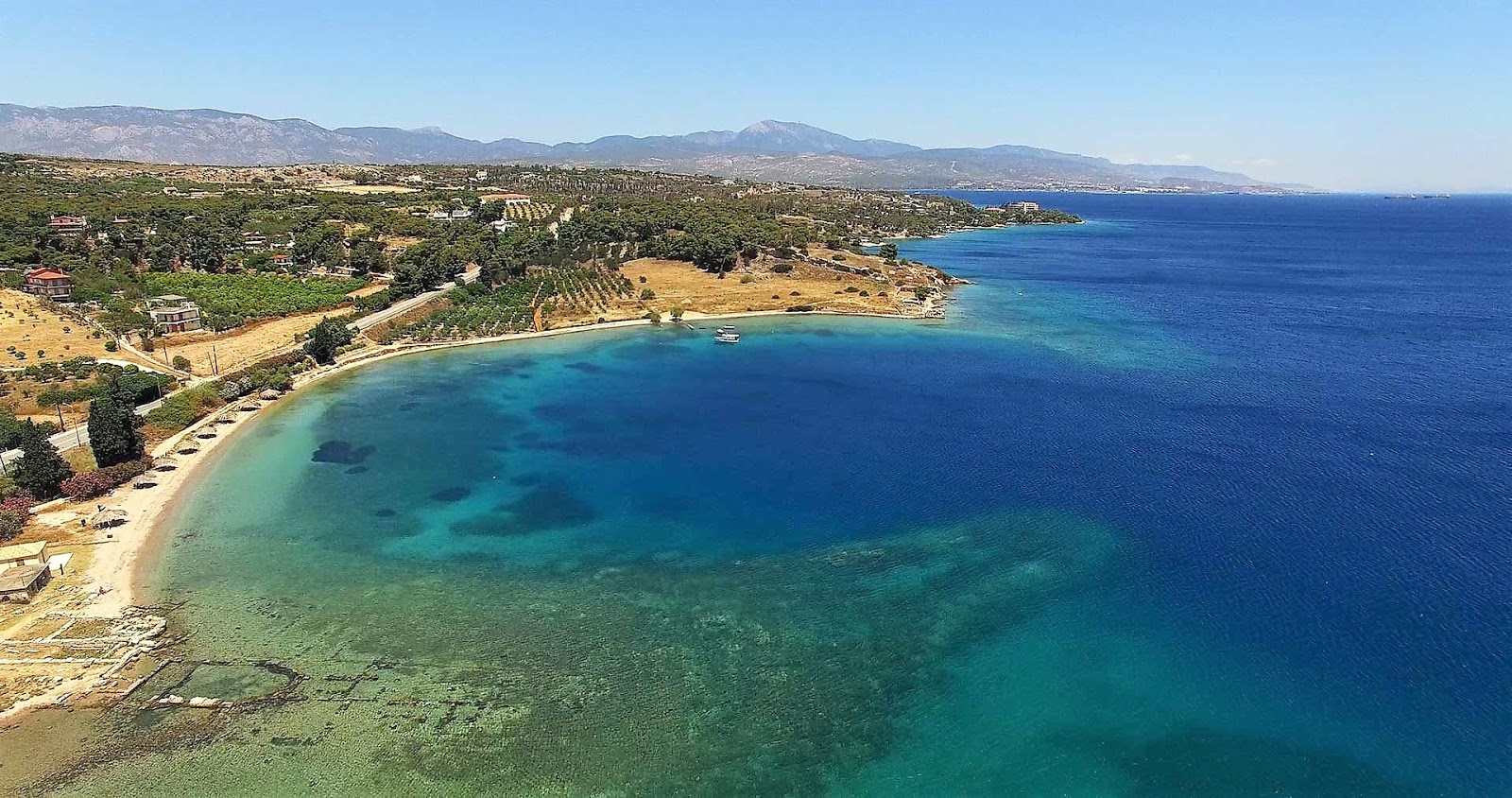
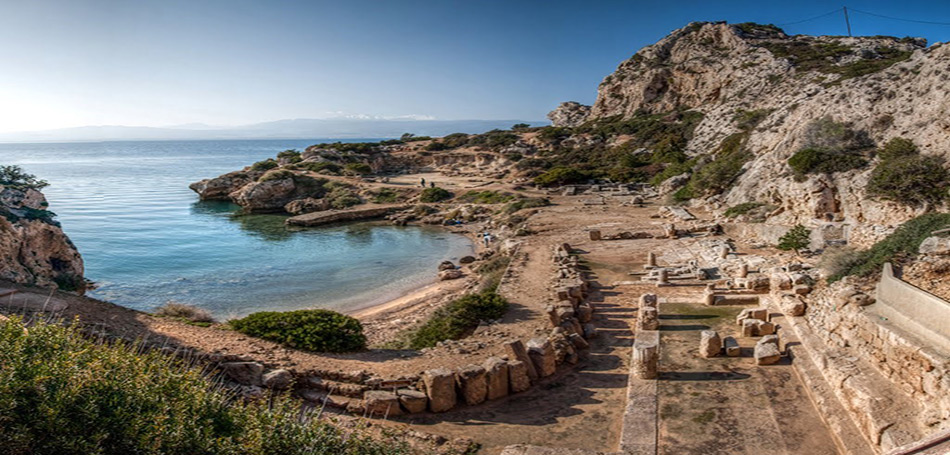
HERAION OF PERACHORA
The Heraion of Perachora (Greek: Ηραίο Περαχώρας) is a sanctuary of the goddess Hera situated in a small cove of the Corinthian gulf at the end of the Perachora peninsula. In addition to a temple of Hera of unusual construction and antiquity, the remains of a number of other structures have also been found, including an L-shaped stoa, a large cistern, dining rooms, and a second potential temple. The Sanctuary of Hera at Perachora is 14.2 kilometres (8.8 mi) north-northwest of Corinth and 75.9 kilometres (47.2 mi) west of Athens. Although there is debate between Argos, Megara and Corinth, the sanctuary was probably under the control of Corinth, as it faced the harbors of that powerful city across the Corinthian gulf. Cult activity at the site continued from perhaps the 9th century BCE to 146 BCE, when the Roman general Mummius sacked Corinth during the war with the Achaean League. In the Roman period, domestic structures were built on the site, indicating that the area was no longer a sanctuary. This site is significant for the study of the origins of Greek temple architecture and rural cults.
ANCIENT OLYMPIA
In western Peloponnese, in the so-called “valley of the gods”, Ancient Olympia grew to be the most celebrated sacred site of Ancient Greece, and the birthplace of the Olympic Games, the most important sports events in all antiquity: starting from 776 B.C., all Greeks – across the then known world – would be united every four years and all hostilities would be suspended so that everyone could take part in these games in the true spirit of sportsmanship. Olympia is now, as it used to be in the past, a famed destination, a powerful landmark known the world over.
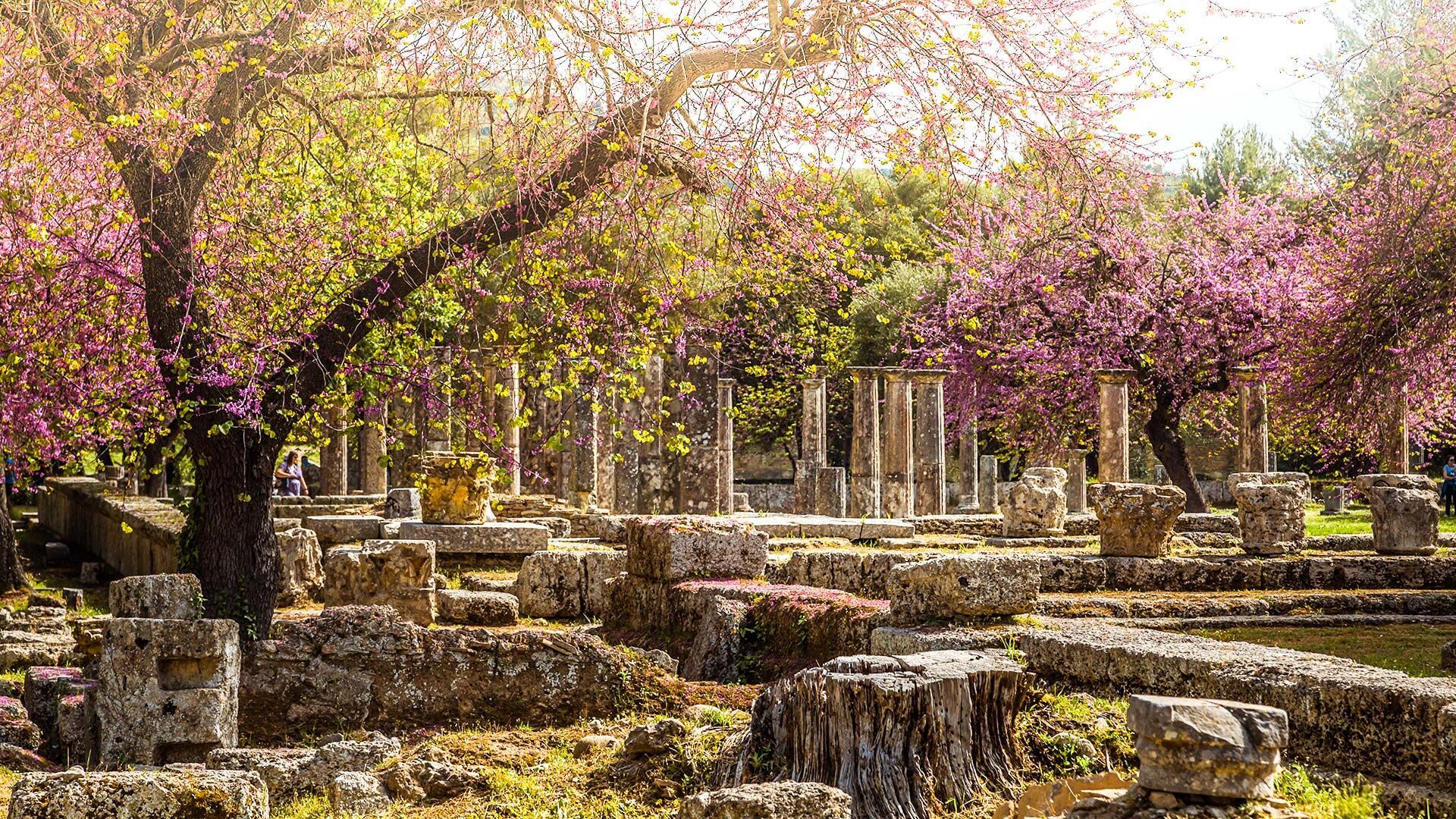
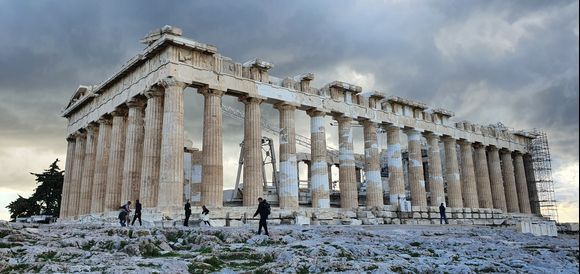
ACROPOLIS
The Acropolis of Athens is an ancient citadel located on a rocky outcrop above the city of Athens and contains the remains of several ancient buildings of great architectural and historical significance, the most famous being the Parthenon. The word acropolis is from the Greek words ἄκρον (akron, “highest point, extremity”) and πόλις (polis, “city”).[1] The term acropolis is generic and there are many other acropoleis in Greece. During ancient times the Acropolis of Athens was known also more properly as Cecropia, after the legendary serpent-man, Cecrops, the supposed first Athenian king.
While there is evidence that the hill was inhabited as far back as the fourth millennium BC, it was Pericles (c. 495–429 BC) in the fifth century BC who coordinated the construction of the buildings whose present remains are the site’s most important ones, including the Parthenon, the Propylaea, the Erechtheion and the Temple of Athena Nike.[2][3] The Parthenon and the other buildings were seriously damaged during the 1687 siege by the Venetians during the Morean War when gunpowder being stored in the Parthenon was hit by a Venetian bombardment and exploded.[4]
THE ARCHAELOGICAL SITE OF DELPHI
The archaeological site of Delphi is situated at a distance of 400m from the present-day village of Delphi on the road between Arachova-Amphissa-Itea.The modern road divides and delimitates the two ancient sanctuaries, namely the Sanctuary of Athena Pronaia to the south and the Sanctuary of Apollo to the north. The sanctuary of Athena Pronaia comprises the Tholos, the temples of Athena and two (at least) treasuries, whereas next to it the impressive gymnasium is situated.
Along the sanctuary of Apollo the Sacred Way ran, on both sides of which the Treasuries of the Greek cities were gradually built and ex-votos and monumental sculpted complexes were erected. The Sacred Way ends at the Temple of Apollo, which comprised the Oracle of Delphi in antiquity, whereas the theatre rose above the sacred area. Outside of the sacred precinct public buildings were constructed, such as the Western Portico and the Stadium, the latter situated on the highest point of the archaeological site.

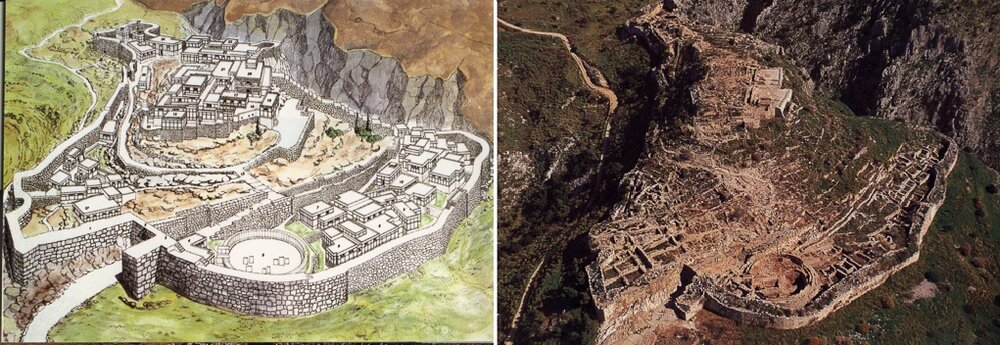
ANCIENT SITE OF MYCENAE
Located in eastern Peloponnese, the archaeological site of Mycenae is among the most important places in mainland Greece. Even mentioned by the epic poet Homer and the geographer Pausanias, Mycenae was the most powerful town of its days and even gave its name to an entire historical period, the Mycenaean period.
The Mycenaean civilization dates from 1,600 BC to 1,100 BC approximately, reaching its peak between 1,400 BC and 1,200 BC. History testifies that the Mycenaeans were great warriors and followed a severe social scale, with the king on top. They did not develop the arts much and there are no recorded facts of extensive trade between Mycenae and other city-states, although Mycenaean pots have been found in the Mediterranean basin, most in southern Italy and even in Egypt.
ARCHAEOLOGICAL MUSEUM / ARCHEOLOGICAL SITE OF ISTHMIA
The museum was built in 1970 by the architect Paul Mylonas and opened to the public in 1978. It contains collections of finds from the sanctuary of Poseidon, the sanctuary of Palaimon, the Hellenistic settlement at Rachi, and from the excavations in the area of Isthmia and the ancient harbour of Cenchreai.
The most important items of the exhibition are:
– Marble perirrhanterion. The basin is supported on four korai (female statues) alternating with busts of bulls or rams. It was found in the sanctuary of Poseidon and dates from the third quarter of the 7th century BC.
– Stone jumping-weights. One of them is inscribed and dates from the middle of the 6th century BC.
– Bronze helmets of the “Scythian type” from the sanctuary of Poseidon. Dated to the 6th or the 5th century BC.
– Statue of Amphitrite. Upper part (the head is missing) of the cult statue of Amphitrite, which stood inside the temple, next to the statue of Poseidon. Dated to the Antonine period, in the 2nd century AD.
– Marble head of an athlete. Head of a young victor of the games, dated to the Roman period.
– Marble votive stele of a victor at the Isthmian Games. Dated to the end of the 2nd century AD or later.
– Mosaics of glass panels. Mosaics made of glass and a kind of plaster in the “opus sectile” technique, bearing pictorial representations of water birds and plants, the view of a harbour and the figure of a philosopher. They were found at the ancient harbour of Cenchreai and were probably imported from Egypt. Dated to the second half of the 4th century AD.
– Decorative ivory plaques from the ancient harbour of Cenchreai. Dated probably to the 4th century AD.
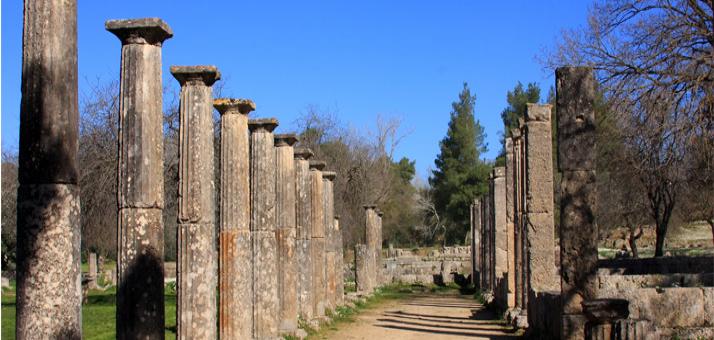
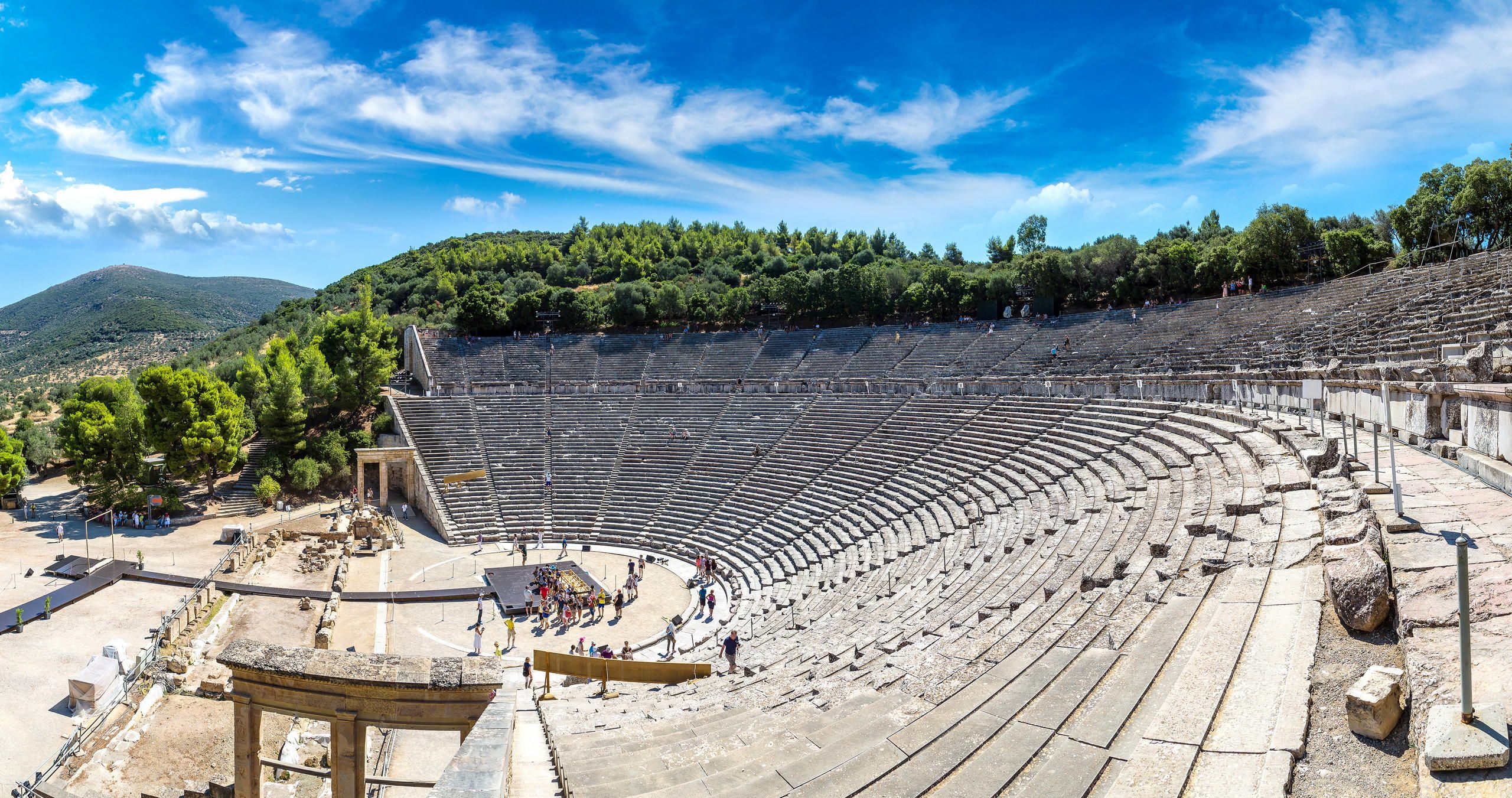
ARCHAEOLOGICAL SITE AND MUSEUM OF EPIDAURUS
The Archaeological Museum of Epidaurus is located inside the archaeological site, between the Ancient Theatre and the Asklepieion. Established in 1897, the museum was important to store and exhibit the findings of the long excavation on the sanctuary of Asklepios (1881-1928), which were supervised by the archaeologist Panagis Kavvadias.
The construction of the building was completed in 1900 and it opened as a museum in 1909. The building is among the oldest archaeological museums in Greece. In fact, the exhibition of the museum, also organized by Panagis Kavvadias, is old and constitutes a characteristic sample of museology concept of the early 29th century, with dense exhibit ranking in a limited room. This point also shows the need for the construction of a new, modern museum in Epidaurus.
LAKE STYMPHALIA
Lake Stymphalia (Greek: Λίμνη Στυμφαλία – pron. “Límnē Stymphalía”) is located in the north-eastern part of the Peloponnese, in Corinthia, southern Greece.[1] It is a closed karst basin with a wetland area and an agrarian area. The lake is an important stopover for migratory birds. The size of the lake varies, depending on the season.
Usually this area around the lake is fairly dryerfoot.[1] In certain weather conditions thousands of small green frogs hide in the damp grass from the aquatic snakes. These frogs are invisible in the grass until you almost step on them, at which they jump out of the way, usually landing on another frog which also jumps. The effect is of ripples of frogs travelling outwards with every step. The area is rich in birds, amphibians and plant life.[1] Other wildlife, such as weasels, can also be seen.
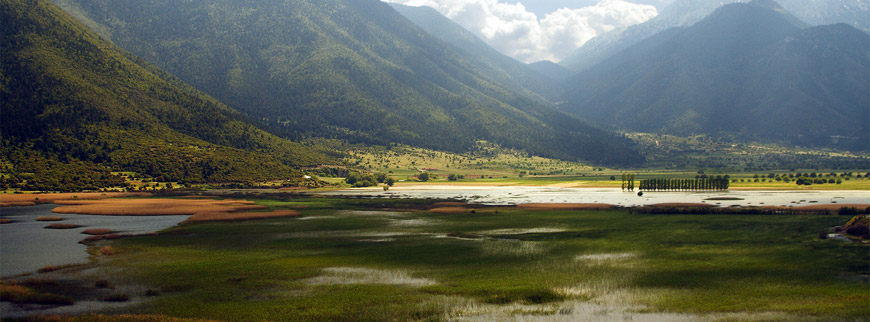
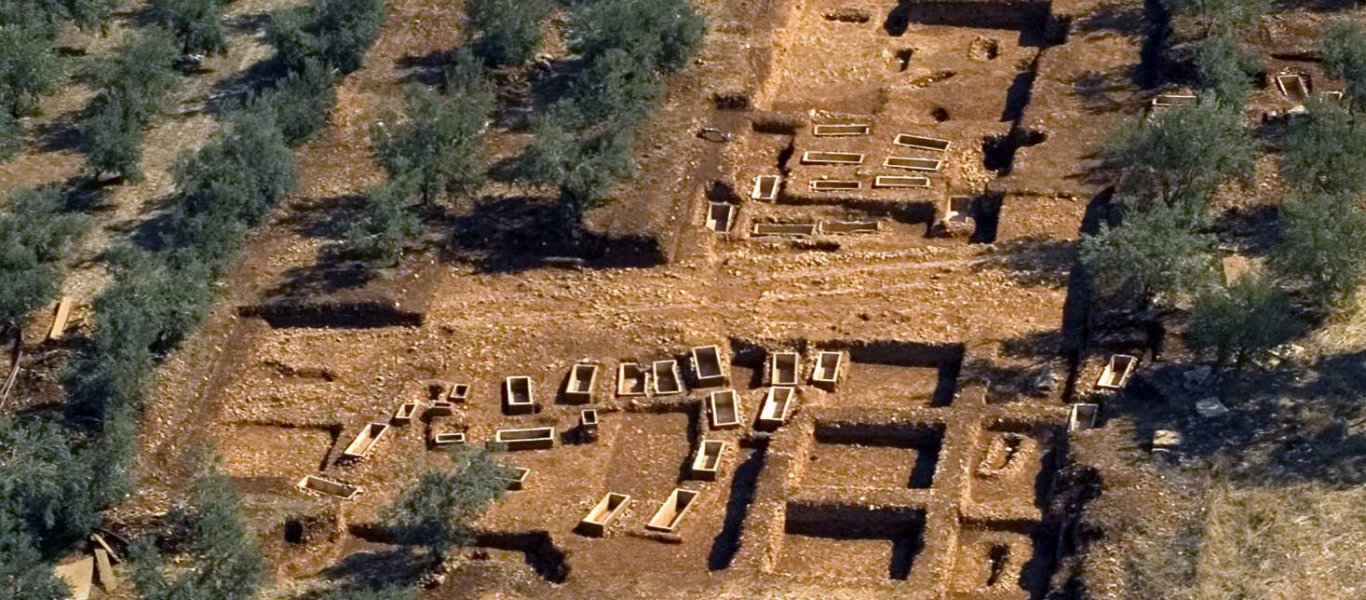
ARCHAEOLOGICAL SITE OF TENEA
Between Chiliomodi and Klenia, lies the important city of Tenea. According to Pausanias, its first inhabitants were Trojans, who had been captured by the Greeks in Tenedos and were transferred there as prisoners. King Agamemnon allowed them to build houses. Poet Virgil claims that Tenea and Rome were both made by Trojans. Also, according to the legend, it is the place where Polyvos raised Oedipus. The first important finding in the area, is Apollo (Kouros) of Tenea. The famous statue of the 6th BC. century, which was excavated in 1854. In 2010 two more statues were found in discovered cemetery, which crosses the ancient roads. Its creation is estimated around the 6th, 5th and 4th century BC. The two statues are now on display at the Archaeological Museum of Ancient Corinth.
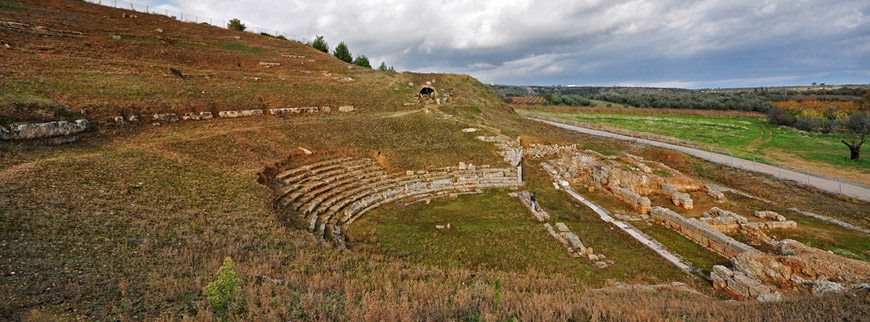
ANCIENT SICYON ARCHAEOLOGICAL SITE AND MUSEUM
Sikyon was the most important artistic center in the Peloponnese. It was home to the renowned sculptor Lysippos and the center where the art of painting developed in antiquity.
In the archaeological site one can admire the imposing theater, the gymnasium, the bouleuterion, as well as the 6th c. B.C temple which was turned into a basilica during the Christian era. Also impressive are the roman baths, which are today housed inside the Archaeological Museum.
ARCHAEOLOGICAL SITE AND MUSEUM OF NEMEA
The Sanctuary of Zeus at Nemea developed in the beginning of the 6th century BC, with the institution of the Panhellenic Nemean Games in a region where human activity had been present since prehistoric times. The first temple of Zeus and the first two phases of the Heroon were constructed during the Archaic period while nine “Oikoi-Treasuries” were erected in the 5th century BC. At the end of the 4th century BC, a new temple of Zeus, baths, a hostel, a Stadium and the 3rd phase of the Heraion were built as part of a large construction project. After the transfer of the games to Argos, in 270 BC, the sanctuary fell into decline. During the 5th and the 6th centuries AD, a small community grew in the vicinity and a basilica was erected on the ruins of the hostel. This community was dissolved during the raids of the Slavs in 580-590 AD.
